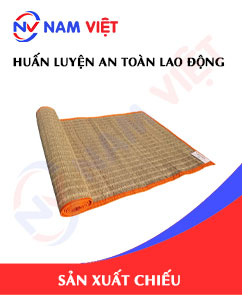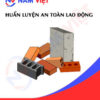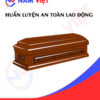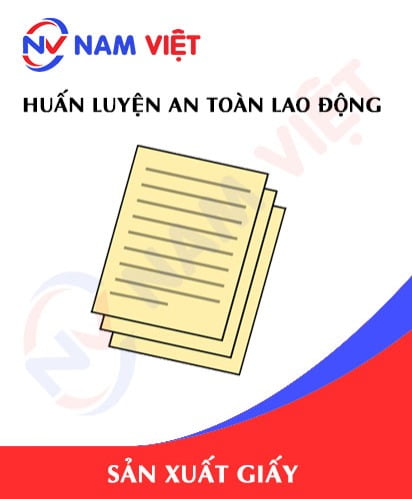Occupational safety training in mat production
99,000 ₫
Note: The above price is calculated for one person, and the price may fluctuate depending on the number of trainees participating in the course and market movements. For more accurate pricing support, please refer to the price list or contact our consulting staff directly.
Occupational safety is an important issue in mat production factories and needs to be addressed promptly to ensure the health and safety of workers, as well as to enhance the reputation of businesses. The Occupational Safety Training course is one of the effective solutions to raise awareness about accident prevention for workers participating in mat production.
Table of Contents
Toggle1. Overview of Mats
a. What is a mat?
A mat (also called a mat) is a common household item used to cover the floor, bed, or used when sitting or lying down to provide comfort and softness. Mats are typically made from materials such as bamboo, bamboo leaves, reed, cotton, felt, leather, wool, fabric, and may have an inner lining to increase elasticity and softness.
Mats can have different colors and patterns to suit the preferences and decoration style of the user. In addition to providing comfort when lying or sitting, mats can also be used to create seating areas for picnics, outdoor activities, or other extracurricular activities.

b. Types of machinery for mat production
During mat production, several types of machinery and equipment are used for different stages. Below are some commonly used machines in mat production:
- Looms: These are essential machines for creating fabric pieces for mats. Looms are used to produce patterns and fabric textures according to requirements. Looms can be adjusted to create different types of fabrics, from bamboo, felt, to wool and cotton fabrics.
- Cutting and trimming machines: After the fabric is woven, cutting and trimming machines are used to cut the fabric into smaller pieces with specific sizes and shapes for mats. Trimming machines can be programmed to cut according to templates or specific dimensions.
- Sewing machines: Sewing machines are used to join fabric pieces together to create a complete mat. They can be automatic or industrial sewing machines, depending on the production scale.
- Printing machines: For mats with patterns, printing machines are used to directly print designs or patterns on the fabric. Printing technologies may include heat printing, direct printing, or digital printing to create diverse designs and colors on mats.
- Pressing machines: Pressing machines are used to press waterproof materials or linings onto mats to enhance durability and elasticity. Pressure, temperature, and pressing time may vary depending on the type of mat being produced.
- Edge-cutting machines: Edge-cutting machines are used to trim and finish the edges of mats. They may have cutting blades and adjustment devices to produce precise and attractive edges.

c. Mat manufacturing companies in Vietnam
Below are some mat manufacturing companies in Vietnam:
- Chuyen Gia Mat Co., Ltd: One of the leading companies in mat production and trading in Vietnam. The company provides mats made from bamboo, bamboo leaves, reed, and fabric, with a variety of designs and quality.
- Quang Thanh Mat Production and Trading Co., Ltd: Specializes in producing and supplying mats such as bamboo mats, bamboo leaf mats, reed mats, and fabric mats with diverse designs and styles.
- Hong Hac Mat Investment and Trading JSC: A reputable company in the mat industry. The company supplies mats made from bamboo, bamboo leaves, reed, and fabric with a variety of designs and patterns.
- Truong An Mat Production and Trading Co., Ltd: Specializes in producing and supplying mats such as bamboo mats, bamboo leaf mats, reed mats, and fabric mats with high quality and competitive prices.
- Hung Yen Mat Production and Trading Co., Ltd: One of the well-known mat manufacturing and trading companies in Vietnam. The company offers bamboo, bamboo leaf, reed, and fabric mats with diverse designs and guaranteed quality.
Note that the above list provides only some examples and does not cover all mat manufacturing companies in Vietnam. Many other companies also operate in this field and can be found through further research.

d. Specific jobs in a mat production factory
Group 1
- Executive director, deputy executive director, department heads in the mat production factory.
Group 2
- Safety officers: manage safety in the factory, design safety procedures, monitor and enforce employees’ compliance with safe work procedures.
Group 3
- Raw material preparation: Collect and prepare materials such as bamboo, bamboo leaves, reed, fabric, and other necessary materials for mat production. Inspect quality and select suitable materials for each type of mat.
- Weaving and pattern making: Use looms to create fabric pieces with desired patterns and textures. Assemble fabric pieces to make mats according to size and pattern requirements.
- Cutting and processing: Use cutting machines to cut fabric into small pieces of desired sizes and shapes. Process mat edges by sewing, stitching, or adding trims for aesthetics and durability.
- Pattern printing (if any): Use printing machines to print patterns directly on the fabric. Ensure accuracy and attractiveness of the printed designs on mats.
- Assembly and finishing: Join fabric pieces together by sewing or other methods to create a complete mat. Check quality and finishing. Pack and prepare products for delivery to customers.
- Quality control: Conduct quality checks on each product to ensure standards and customer requirements are met.
- Maintenance: Perform maintenance on machinery and equipment to ensure efficient and sustainable factory operations.
Group 4
- Office work, support, sales, marketing.
- Production management, quality management, human resources management, material management, financial and accounting management.
- Research and development of new products, designing product packaging and styles.
2. Overview of occupational safety training for mat production
In this article, we focus on issues related to Group 3, because Group 3 is directly involved in production and faces the highest occupational safety risks. For more information on other groups, see here.
a. What is Group 3 occupational safety training?
- Group 3 occupational safety training consists of sessions that equip workers with awareness on preventing workplace accidents.
- The training course helps workers recognize hazards and avoid risks, reducing the likelihood of workplace accidents during work.
REGISTER FOR OCCUPATIONAL SAFETY TRAINING
b. Training duration
Initial safety training duration
- Total training duration is at least 24 hours, including examination time.
- 8 hours of theoretical study on safety policies and labor hygiene laws
- 8 hours of theoretical study on basic occupational safety and hygiene knowledge
- 4 hours of theoretical study on specialized training content
- 2 hours of practical study on specialized training content
- 2 hours for the final theoretical examination
The safety training center will divide the time into multiple sessions depending on workers’ schedules. Typically, there are 6 sessions over 3 days if the company can arrange continuous training.
Periodic safety training duration
- Before the occupational safety card expires, workers must undergo periodic occupational safety training with periodic training duration of at least 50% of the initial training duration.
Explanation: The total periodic occupational safety training time is at least 12 hours, including examination. After completing the periodic training and passing the test, the worker will have their occupational safety card reissued or extended.
c. Training course content
| No. | TRAINING CONTENT | TRAINING DURATION (HOURS) | |||
| Total | Including | ||||
| Theory | Practice | Test | |||
| I | Safety policies and labor hygiene laws system | 8 | 8 | 0 | 0 |
| 1 | Overview of legal documents on occupational safety and hygiene. | 6 | 6 | ||
| 2 | System of safety and hygiene standards and technical regulations. | 1 | 1 | ||
| 3 | Specific regulations from state management agencies regarding safety and hygiene in constructing, expanding, or renovating facilities, using and inspecting machines, equipment, materials, and substances requiring strict safety and hygiene measures. | 1 | 1 | ||
| II | Basic knowledge of occupational safety and hygiene | 8 | 8 | 0 | 0 |
| 1 | Basic knowledge about hazards and harmful factors in the workplace. | 4 | 4 | ||
| 2 | Methods to improve working conditions. | 1 | 1 | ||
| 3 | Safety culture in production and business. | 1 | 1 | ||
| 4 | Rights and obligations of employers and employees; safety policies and labor hygiene for employees; functions and duties of the safety network and safety officers. | 1 | 1 | ||
| 5 | Safety and hygiene regulations, signs, instructions, use of safety equipment and personal protective equipment; skills in first aid and occupational disease prevention. | 1 | 1 | ||
| III | Specialized training content | 6 | 4 | 2 | 0 |
| Comprehensive knowledge about machines, equipment, substances causing hazards; risk analysis and management for occupational safety; safe work procedures with machines, equipment, and hazardous substances. | 6 | 4 | 2 | ||
| IV | Final safety training test | 2 | 2 | 0 | 0 |
| Total | 24 | 22 | 2 | ||
See also training content of all 6 groups
d. Occupational safety card
After completing the occupational safety training and passing the test, the worker will be issued an occupational safety card (commonly called Group 3 safety certificate).
The Group 3 safety card clearly shows information such as name, date of birth, specific job and working environment, training duration, official stamp, and signature confirming completion of the training.
According to regulations on card issuance stated in Clause 2 of Article 24, Decree 44/2016/ND-CP, there are two cases:
- If the employer and employee have a labor contract, the employer must sign, stamp, and authenticate the safety card for the trained Group 3 worker after completing training and passing the test.
- If the worker is freelance or seasonal, without a labor contract, the training unit must sign, stamp, and authenticate the safety card after the worker completes training and passes the test.

3. Identifying Hazards Affecting Workers in Mat Production
During mat production, workers may encounter various hazards and potential impacts. Below are some common hazards that can affect workers in the mat manufacturing industry:
- Physical injury risk: Workers may face the risk of injury from using sharp tools, machinery, and equipment during cutting, sewing, and processing mats. This may include cuts, abrasions, eye and ear injuries, and slips or falls.
- Chemical risk: In mat production, materials and chemicals such as glue, printing ink, waterproofing agents, and cleaning chemicals may be used. Workers may be exposed to these substances via skin contact, inhalation, or ingestion, causing skin irritation, respiratory issues, or health problems if not used properly or without protective measures.
- Work safety risk: Machinery and equipment in mat production factories can pose hazards if not operated correctly or if safety regulations are not followed. For example, risks of crushing, collisions, entanglement, electric shock, and other serious accidents.
- Health risk: Some tasks in mat production may require workers to work in wet environments, dusty areas, or in high noise levels. This can lead to respiratory problems, hearing and vision issues, and overall physical stress.
- Fire and explosion risk: Some mat production processes may involve the use of flammable substances or have the risk of fire and explosions.

4. Common Work Accidents in Mat Production
Some common work accidents in mat production include:
- Cutting and injury accidents: Risk of hand cuts and injuries from using sharp tools such as scissors, knives, and cutting machines during mat cutting, sewing, and processing.
- Machinery accidents: Risk of crushing, entanglement, or debris projection when working with machinery and equipment in mat production. This can occur if machinery is not properly maintained or used unsafely.
- Slips and falls: These accidents may occur when working on slippery surfaces, uneven floors, or due to lack of caution while moving around the work area.
- Chemical poisoning: Exposure to materials and chemicals such as glue, printing ink, and waterproofing agents can cause poisoning or irritation to the skin, eyes, and respiratory tract.
- Fire and explosion accidents: In certain cases, using flammable substances in mat production may cause fire or explosion accidents if safety rules are not followed.
- Work environment-related health issues: Risk of diseases related to work environment factors such as dust, noise, strong light, humid air, and repetitive movements.
5. Safety Measures in Mat Production
When participating in mat production, workers need to follow important safety measures to ensure safety and prevent accidents. Below are some basic safety measures:
- Training and guidance: Provide safety training and instructions to all employees regarding safe work procedures, rules for using personal protective equipment, and hazard prevention measures.
- Use of personal protective equipment (PPE): Ensure all workers properly and fully use PPE such as helmets, safety goggles, masks, gloves, and safety shoes to protect key body parts.
- Equipment inspection and maintenance: Ensure that machinery and equipment are regularly inspected, maintained, and repaired to operate correctly and safely.
- Material and chemical management: Store, use, and handle materials and chemicals according to safety regulations. Ensure workers know how to use, clean, and store materials and chemicals properly.
- Work environment monitoring: Ensure the work environment is controlled and meets safety standards for lighting, temperature, humidity, ventilation, noise, and dust management.
- Proper tool use and storage: Use tools and equipment correctly according to instructions. Ensure tools are inspected, maintained, and stored properly to prevent accidents.
- Fire and explosion risk management: Implement fire prevention and firefighting measures, install alarm systems, and provide adequate fire equipment throughout the mat production factory.
- Work area organization: Arrange the workspace safely and comfortably. Ensure sufficient space, cleanliness, no obstacles, and adequate lighting.
- Follow safe work procedures: Adhere to safe work procedures, including correct use of tools and machines, not exceeding load limits, and avoiding work while fatigued or distracted.
- Reporting and hazard assessment: Encourage reporting and assessing hazardous situations, accidents, or other safety concerns. Foster a safety-conscious environment and encourage employee participation in improving workplace safety.
- Regular work environment monitoring in the factory, collecting and analyzing harmful factors to adjust and reduce hazards to prevent occupational diseases.
6. Benefits of Occupational Safety Training in Mat Production
An Toan Nam Viet provides your business with the following benefits after completing occupational safety training courses as regulated by Decree 44/2016/NĐ – CP on occupational safety and hygiene for companies, factories, and enterprises.
- Workers can identify potential accident risks and take preventive measures to avoid workplace accidents.
- Your business can establish risk prevention measures in production, operation, and maintenance processes.
- Minimize costs associated with occupational safety hazards.
- Uninterrupted production helps increase labor productivity and product quality.
- Compliance with occupational safety laws avoids legal risks.
- Enhances credibility and professionalism in all aspects, thereby improving your company’s brand.
Nam Viet’s training courses serve as a solution to prevent external hazards from affecting individuals, allowing them to avoid dangers that could lead to injuries or worse, death.
REGISTER FOR OCCUPATIONAL SAFETY TRAINING
7. Customer Feedback After Completing Mat Production Safety Training
An Toan Nam Viet has many years of experience accompanying various businesses in Vietnam, especially in the southern provinces. This responsibility is invaluable to An Toan Nam Viet, which is why our Occupational Safety Training is increasingly professional. The motivation for An Toan Nam Viet’s growth comes from positive feedback and suggestions from businesses. Below are some testimonials from our partners we have served.
Bac Nam E&C Construction Investment Joint Stock Company
“Using An Toan Nam Viet for the first time, I was pleasantly surprised by the 24/7 support from the consulting team. The class organization was very quick and convenient for our company. Thank you very much for the service!”
Hoa Dat Construction and Trading Joint Stock Company
“An Toan Nam Viet’s service greatly helped us simplify occupational safety procedures and complete safety documentation for work. The consulting team was enthusiastic and timely in addressing our questions. 5 stars for An Toan Nam Viet.”
See more customer interviews after using An Toan Nam Viet services
8. An Toan Nam Viet Occupational Safety Training Capability
An Toan Nam Viet is a reputable and high-quality occupational safety training center in Vietnam. Safety training sessions are continuously conducted at factories, production facilities, or construction sites nationwide (63 provinces in Vietnam).
REGISTER FOR OCCUPATIONAL SAFETY TRAINING
Occupational Safety Training License
- An Toan Nam Viet has been inspected and certified by the Department of Safety under the Ministry of Labor, War Invalids and Social Affairs and has been issued a certificate meeting the conditions for occupational safety and hygiene training. This further strengthens our training capability.

Training Materials and Lectures
- Before being used in OST courses, all materials are reviewed to ensure accuracy and effectiveness.
- Teaching methods of instructors are standardized according to An Toan Nam Viet standards, researched and developed by experts to maximize knowledge absorption.
Facilities
- Controlling classroom factors increases teaching efficiency and knowledge absorption.
- Our training facilities provide spacious classrooms with proper lighting, training equipment, and more.
9. Nationwide Reputable Safety Training Center
At An Toan Nam Viet, we prioritize the professionalism of occupational safety training. Educating workers to protect themselves equips them with safety knowledge for their livelihood and contributes to national development.
We meticulously prepare all aspects, from tools and equipment to teaching materials, sound, and lighting.
Our safety instructors are experts with years of experience, even with research projects identifying hazards in various industries and how to prevent them.
Lectures are practical and engaging, making it easy for workers to absorb knowledge. All content aligns with Decree 44/2016/NĐ-CP.
Workers learn safety measures and how to protect themselves, applying them effectively in real work scenarios.
Our training center is proud to provide professional, reputable occupational safety training with advantages:
- Competitive training costs while ensuring quality.
- Flexible training schedules compatible with company production.
- Quick certification procedures in accordance with the law.
- Experienced instructors with long-term industry expertise.
- Classroom conditions optimized for effective teaching and learning.
- Lectures tailored for occupational safety in enterprises.
- An Toan Nam Viet provides dedicated, professional, and fast support to customers.

10. Additional Reference Materials for Mat Production Safety Training
- Occupational Safety Training Materials
- Mat Production Occupational Safety Materials
- Occupational Safety Training Test Materials
- Mat Production Occupational Safety Training Curriculum
- Mat Production Occupational Safety Quiz
1 review for Occupational safety training in mat production
No comments yet















namchinh.haiphong341
Dịch vụ huấn luyện an toàn lao động rất tốt nhé, giảng viên dạy rất sinh động dễ hiểu!